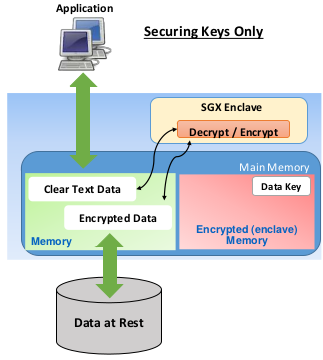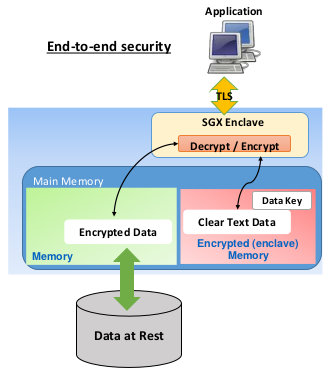Securing the Storage Data Path with SGX Enclaves
| Venue | Category |
|---|---|
| arxiv | Storage SGX |
Securing the Storage Data Path with SGX Enclaves1. SummaryMotivation of this paperMethod NameImplementation and Evaluation2. Strength (Contributions of the paper)3. Weakness (Limitations of the paper)4. Some Insights (Future work)
1. Summary
Motivation of this paper
This paper intends to explore the use of SGX enclaves as a mean to improve the security of handling keys and data in storage systems.
- Motivation this paper studies the performance of securing the data path and hardening the security of data-at-rest encryption in storage systems.
such as block storage systems, file systems or object storage.
- high throughput, comparable to running the same operation without enclaves.
- the subtleties arise from using SGX
how much development work is required in order to get acceptable performance?
- quantify the performance effect of the storage encryption use-case, and understand the subtleties involved that may affect a wide array of other use cases.
Method Name
- SGX performance overhead
- the actual overhead of accessing the encrypted memory via the MEE.
- the overhead associated with entering and exiting an enclave.
ECALLs (defined in an "edl" file) has a performance impact due to the CPU's context switches. the limitation of the EPC size, and when operating with memory that exceeds the EPC size there is a need for paging of EPC pages to regular memory. (additional latency, encryption of this data before it lands in regular memory)
- Data-at-rest encryption either clear text or encrypted in transit (e.g., HTTPS), and then encrypted before being persisted to disk.
ensure that all persistent data is always encrypted, so that loss of hardware (e.g., malicious user, hardware failure), does not compromise the data.
- Software encryption the encryption keys must reside in clear text in memory, presenting a significant security risk.
sensitive data keys are vulnerable to either privileged users or to memory sniffing techniques.
- Protecting the keys using SGX By placing the software encryption process and key handling inside enclaves.
perform all encryption and decryption in SGX
Enclaves are allowed to access the general memory, and so data buffers (both encrypted and cleartext) can reside outside of the enclaves memory.
call ECALL, gets pointers to two buffers in the general (non-encrypted) memory.

- End-to-end Data protection Data-in-transit encryption is now required in many scenarios.
via one of the prevalent standards such asa HTTPS, SSL, TLS.

Implementation and Evaluation
- Evaluation
- implement four variations of the function find_max.
ECALL, in, user_check in: copy the data to enclave. user_check: without copying it into the enclave's memory.
- data encryption (AES128-GCM)
trusted: sgxsdk, sgxssl untrusted: openssl
result: openssl > sgxssl > sgxsdk
- The effect of multiple threads
Multiple processes Multiple threads with a single enclave Multiple threads with separate enclaves
2. Strength (Contributions of the paper)
- the most important thing mentioned by this paper is without actual performance testing, it is difficult to predict the performance of computations running inside an SGX enclave.
choosing buffer sizes, library configuration
3. Weakness (Limitations of the paper)
4. Some Insights (Future work)
- In this paper, it mentions the original concept of SGX. created with less ambitious use cases in mind, in which minimal parts of the computation (and the code associated with it) are placed into enclaves.
only a saml part of the application needs to reside in an enclave. data transformations, local test on data, and cryptographic functions on data blocks.
- It also mentions some workloads are bad fro SGX performance.
require frequent small random access operations require a very large amount of data to be in encrypted memory simultaneously
- SGX basis Memory encryption engine (MEE): perform real time encryption of all communication between the CPU and the memory.
MEE is only invoked on a special designated area of the memory called the Enclave Page Cache (EPC). (128MB: 96MB after reducing space used for managing the enclaves).